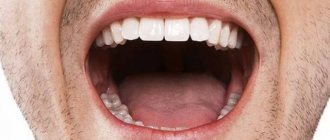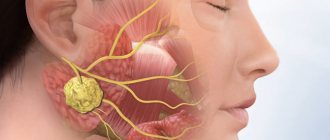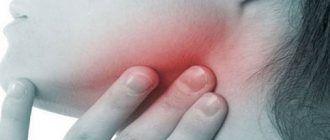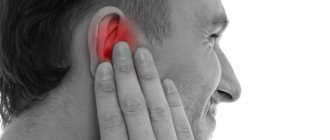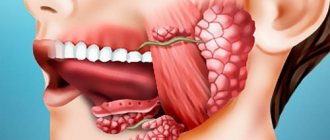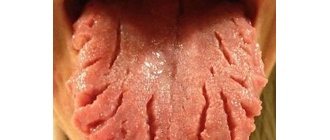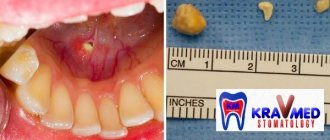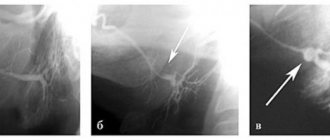Sialadenosis is a non-inflammatory disease of the salivary glands, leading to enlargement and/or disruption of their function. The lesion is dystrophic in nature and is not associated with the appearance of tumors. Structural changes in gland tissue usually appear against the background of other systemic pathologies. Dentists quite often encounter this phenomenon: 1 case out of 10 pathologies of the salivary glands is represented by sialadenosis.
The disease usually occurs in middle-aged people. Since it often accompanies endocrine, allergic, dysmetabolic and other systemic diseases, the approach to treatment should be carried out not only from the dental side.
Classification
You should consider the classification of sialadenitis, which is divided according to the forms and mechanisms of flow:
- Acute - divided into types:
- Viral - often provoked by the influenza virus, the causative agent of mumps, cytomegalovirus. Also called influenza, cytomegalovirus, etc.
- Bacterial - penetrates the salivary glands during infectious diseases, after operations, with foreign bodies blocking the salivary ducts.
- Chronic (specific or nonspecific) – there are such types:
- Parenchymatous – affects the parenchyma of the glands. There is a change in the structure of the salivary glands and the formation of cysts. There are stages: initial, clinically pronounced, late.
- Interstitial - the stroma of the connective tissue of the salivary gland is affected. Develops in diabetes mellitus and hypertension. There are three phases: early, pronounced, late.
- Sialodochitis (ductal) - inflammation occurs in the salivary duct.
- Parotitis is an inflammation of the parotid glands.
According to the nature of inflammation, sialadenitis is divided into:
- Serous - discharge in the form of mucus;
- Purulent - discharge in the form of pus;
- Necrotic – formation of necrosis.
According to the stages of flow they are divided into:
- easy,
- average,
- heavy.
The disease progresses to the point where salivation stops, causing stones to form in the salivary ducts. After a while, obstruction of the salivary ducts occurs, after which the inflammatory process resumes with renewed vigor, which is accompanied by swelling and pain in the glands. The result of the absence of any treatment is the transition of purulent inflammation to the peripharyngeal space, the lateral surface of the neck or the mediastinum (the development of mediastinitis).
The inflammatory process can involve either one or several glands. These can be symmetrically located glands or different salivary glands.
go to top
Why does sialadenosis occur?
Sialosis can develop against the background of underlying diseases or be caused by certain physiological reasons. For example, pathology occurs in women during pregnancy and lactation. Pathological changes are often provoked by autoimmune diseases - systemic scleroderma, rheumatism, psoriasis, etc., as well as metabolic and endocrine disorders.
Eating disorders that lead to sialosis include strict long-term diets and restrictions, and anorexia. In general, the most common causes are diabetes mellitus, menstrual dysfunction and thyroid dysfunction, chronic pancreatitis and other gastrointestinal pathologies.
The allergic nature of the disease may be associated with drug allergies. In some cases, sialosis of the salivary glands develops after surgery or trauma in the area of the dental system.
Causes
The cause of sialadenitis of the salivary glands is the penetration of infection into the salivary ducts. These can be various bacteria, viruses, associations, for such diseases or conditions:
- Angina;
- Weakened immunity;
- Syphilis, tuberculosis;
- Flu;
- Parotitis;
- Oncology (tumor);
- Actinomycosis, etc.
Infection can enter through wounds, even cat scratches, animal bites or insect bites. According to the routes of infection, the following types are distinguished:
- Lymphogenous – transfer of infection from nearby lymph nodes;
- Contact – transfer of infection from nearby purulent foci;
- Hematogenous - the transfer of bacteria or viruses through the blood from any organs.
The second cause of sialadenitis is a temporary cessation of salivation. For what reasons?
- For severe infectious diseases;
- After operations on the salivary gland or abdominal cavity;
- When secretion stagnates;
- After injuries to the salivary gland. And also for the following conditions and diseases:
- Dehydration.
- Pathomorphology.
- Syphilis.
- Fever.
- Leukocyte infiltration.
- Hypercalcemia.
- Tuberculosis.
- Atrophy of the mucous membrane.
- Purulent or serous-purulent exudate in the salivary duct.
go to top
Provoking reasons
The factors contributing to the occurrence of sialadenosis are not entirely clear; the disease may be of allergic, immunogenic, hormonal or endocrine origin.
The most common cause of sialosis is systemic diseases, especially hormonal disorders, malnutrition or neurogenic disorders. These include:
- vitamin deficiency: pellagra, vitamin deficiency disease;
- diabetes;
- uremia;
- endocrinopathy: hyperthyroidism;
- alcoholism;
- other hormonal disorders: menopause and andropause;
- diseases caused by malnutrition (eg Kwashiorkor),
- cystic fibrosis.
Factors contributing to the manifestation of the disease are also pregnancy and the use of certain medications.
Swelling of the salivary glands can occur even in the case of a deficiency of vitamins A, B, C. Swelling of the glands is also recorded in severe cirrhosis of the liver - the so-called. cirrhotic sialosis, which is characterized by unilateral swelling of the glands that progresses rapidly over several days.
Symptoms and signs of inflammation of the salivary glands
Symptoms of inflammation of the salivary glands begin to manifest themselves in swelling and pain that occurs when swallowing, touching, turning the head and chewing. Pain sensations radiate to the ear, temple and lower jaw. Often resembles a sore throat or laryngitis. There is a feeling of congestion in the ears and an inability to open the mouth wide. Added to this are the following signs:
- Dry mouth due to lack of salivation. In rare cases, excessive salivation occurs.
- Pus or mucus appears in the saliva, as well as flakes - separated epithelial cells.
- An increase in temperature to a febrile state accompanied by general malaise.
Acute sialadenitis can resolve on its own. But if it turns into a purulent form, which is accompanied by fluctuation, this is often followed by the formation of fistulas, abscesses, narrowing of the salivary duct, phlegmon of the submandibular and parotid region.
Chronic sialadenitis is accompanied by mild symptoms, which manifest themselves in slight swelling, painless or mildly painful condition of the salivary glands. There is little salivation and an unpleasant taste in the mouth. During exacerbations, mucus or pus is released. An abscess develops. The salivary gland changes in size, which feels like a tumor.
The symptoms are largely reminiscent of sialadenitis.
go to top
Classification of sialadenoses
According to the state of the salivary gland, sialadenoses are defined as interstitial, parenchymal and ductal (depending on the predominant changes detected using private and special examination methods). This disease has three stages of development:
- initial (I degree), in which the salivary glands are not enlarged and have normal sizes;
- the stage of pronounced clinical changes (II degree) is accompanied by a slight increase in the size of the salivary glands, which is determined by palpation;
- late (III degree) is characterized by an increase in the size of the salivary glands, which is diagnosed both visually and by palpation.
In addition, sialadenoses are divided into endocrine, neurogenic, allergic and associated with nutritional disorders. In order to determine the degree of development of sialadenosis, a specialist assesses the size of the major salivary glands, taking into account examination and palpation data.
Diagnostics
Diagnosis of sialadenitis of the salivary glands begins with the patient’s complaints, which are checked by a doctor through a general examination. Some external signs indicate features of the disease, which are confirmed by the following diagnostic studies:
- PCR analysis.
- Cytological and microbiological study of secretions.
- Sialometry.
- Linked immunosorbent assay.
- Sialography.
- X-ray of the salivary glands.
- Sialoscintigraphy.
- Thermography.
- Ultrasound of the salivary glands.
- Blood analysis.
- Sialotomography.
go to top
Diagnostic criteria
First of all, a study is carried out by palpation.
The main task of differential diagnosis is to exclude the oncological nature of enlarged salivary glands. For these purposes, computed tomography is performed.
An ultrasound is performed to determine the degree of change in the size of the salivary gland, decrease/increase in echogenicity. Saliva testing helps rule out the presence of an inflammatory agent.
Treatment
Sialadenitis is treated by a dentist, as well as a venereologist, pediatrician, therapist, phthisiatrician and rheumatologist. Each stage of the disease is treated in two main directions: medication and physiotherapy. Surgical intervention is prescribed only if necessary.
How to treat sialadenitis? Using medications:
- Antibiotics;
- Pilocarpine hydrochloride.
- Novocaine blockades;
- Dimexide is used to treat the ducts of the salivary glands;
- Antiviral drugs for the viral nature of the disease;
- Medicines that normalize metabolism;
- Anti-inflammatory drugs;
- Interferon;
- Vitamins;
- Proteolytic enzymes.
If there are significant changes in the structure of the salivary glands and stones or objects are found blocking the duct, surgical intervention is prescribed. The abscess opens. Bougienage is carried out to restore the structure of the salivary glands. Lithoextraction, lithotripsy, sialendoscopy and other procedures are performed to remove elements blocking the duct. It is possible to open the capsule of the gland and its ducts in order to eliminate the contents or completely remove the affected gland if there is no chance of recovery.
How else to treat sialadenitis? With physiotherapy:
- UHF.
- Electrophoresis.
- Massage of the salivary glands.
- Fluctuarization.
- Galvanization.
Sialadenitis of the salivary glands cannot be treated at home. Outpatient treatment is possible only under the guidance of a doctor and in accordance with the medications prescribed by him. Folk remedies will not help - they can only reduce symptoms, but not cure the disease.
The same applies to the diet, which in this case is not followed. We can only recommend eating soft or crushed foods, so as not to cause additional pain, and also focus on vitamin products.
go to top
Symptoms of sialadenoses
Typically, during the development of sialadenosis, patients experience swelling in the area of the salivary glands, which is not accompanied by pain. The enlargement of the salivary glands persists for a long time; their size does not change when eating. With sialadenosis, salivation is often reduced. When examining the patient, a moderate amount of squamous epithelium is observed in the secretion and a change in the configuration of the face, which is caused by symmetrical swelling of the soft tissues. In this case, the enlarged glands have a dense shape to the touch, with a smooth surface. In turn, the manifestation of parenchymal sialadenosis is accompanied by dilation of the excretory ducts. A relative sign of interstitial sialadenosis is narrowing of the excretory ducts. Ductal sialadenosis is accompanied by a stricture of dilated ducts. Sometimes disturbances in the excretory and secretory functions of the salivary glands occur without their visible increase. These conditions are also classified as sialadenoses as a reaction of the parenchyma to various changes in the body: they are manifested by increased or decreased salivation. An increase in the secretion of the salivary glands (hypersalivation) is associated with diseases such as stomatitis, gastric and duodenal ulcers, helminthiasis and even toxicosis during pregnancy. Reduced secretion (hyposalivation) leads to dry mouth, or more precisely to xerostomia. The symptom of dry mouth is often observed in patients with various diseases of the salivary glands and body systems.
Life forecast
Sialadenitis is not considered a fatal disease. However, the life prognosis worsens significantly if the patient ignores treatment. How long do they live with inflammation of the salivary glands? Until complications arise that can lead to serious consequences of their development. The acute form is cured in a couple of weeks, which should encourage the patient to receive early treatment. The chronic form is almost never completely cured. Therefore, one should not delay treatment, the absence of which can lead to tumors, necrosis, phlegmon, the spread of pus, clogging of the salivary duct, and the formation of salivary stones.
Prevention of sialadenitis consists of maintaining oral hygiene, treating all infectious and chronic diseases, strengthening the immune system and timely contacting the dentist if the first signs appear.
